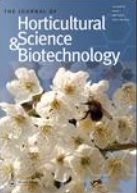Ver ítem
- xmlui.general.dspace_homeCentros Regionales y EEAsCentro Regional Patagonia NorteEEA Alto ValleArtículos científicosxmlui.ArtifactBrowser.ItemViewer.trail
- Inicio
- Centros Regionales y EEAs
- Centro Regional Patagonia Norte
- EEA Alto Valle
- Artículos científicos
- Ver ítem
Comparative movement of labelled nitrogen and zinc in 1-year-old peach [Prunus persica (L.) Batsch] trees following late-season foliar application
Resumen
Late in the season, a double-labelled solution containing 15N-enriched urea and 68Zn sulphate was painted on the entire leaf area of 15, 1-year-old ‘O’Henry/Nemaguard’ peach trees to quantify N and Zn movement out of leaves following foliar application, and redistribution of these nutrients to new growth in the following Spring. About 47% of the labelled N and only 7% of the labelled Zn painted on the leaf surfaces was recovered in the permanent structure
[ver mas...]
Late in the season, a double-labelled solution containing 15N-enriched urea and 68Zn sulphate was painted on the entire leaf area of 15, 1-year-old ‘O’Henry/Nemaguard’ peach trees to quantify N and Zn movement out of leaves following foliar application, and redistribution of these nutrients to new growth in the following Spring. About 47% of the labelled N and only 7% of the labelled Zn painted on the leaf surfaces was recovered in the permanent structure of the trees after leaf fall. Thus, it is concluded that foliar applications of Zn in the Autumn are not very efficient at supplying Zn to peach trees, especially when compared to supplying N as urea sprays in the Autumn. These data raise the possibility that foliar applications of Zn may actually be considered as soil applications, because 90% or more of the foliar-applied Zn may be carried to the orchard floor at the time of leaf fall. Therefore, future research needs to focus on assessing the efficacy of foliar applications for Zn nutrition of fruit trees, and identification of potentially detrimental effects from possible excessive soil accumulation of Zn. Once within the tree, however, labelled Zn was quite mobile and was stored throughout the plant, including in the roots. Of the labelled N and Zn exported from treated leaves prior to leaf fall, a substantial redistribution from storage was evident by 2 weeks after bloom and, by 4 weeks after bloom, 38% and 56% of the labelled N and Zn, respectively, had been redistributed from storage in roots, trunk and 1-year-old shoots to new growth. The biomass of new, above-ground growth tripled between 2 – 4 weeks after bloom and was coincident with a conspicuous influx of both N and Zn from the soil.
[Cerrar]

Autor
Sanchez, Enrique Eduardo;
Weinbaum, Steven A.;
Johnson, R. Scott;
Fuente
Journal of Horticultural Science & Biotechnology 81 (5) : 839-844 (2006)
Fecha
2006-09
Editorial
Taylor and Francis
ISSN
2380-4084
1462-0316
1462-0316
Formato
pdf
Tipo de documento
artículo
Palabras Claves
Derechos de acceso
Restringido
 Excepto donde se diga explicitamente, este item se publica bajo la siguiente descripción: Creative Commons Attribution-NonCommercial-ShareAlike 2.5 Unported (CC BY-NC-SA 2.5)
Excepto donde se diga explicitamente, este item se publica bajo la siguiente descripción: Creative Commons Attribution-NonCommercial-ShareAlike 2.5 Unported (CC BY-NC-SA 2.5)


